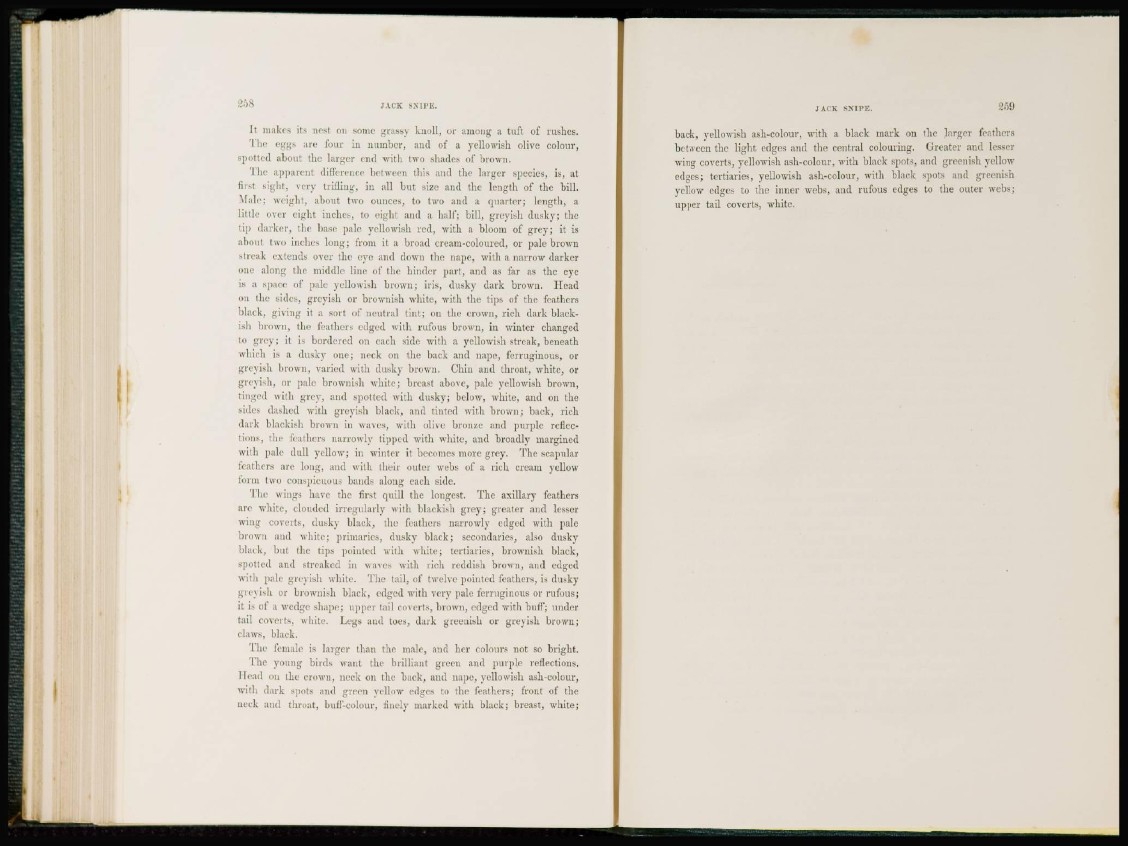
258 JACK SNIPE.
It makes its nest on some grassy knoll, or among a tuft of rushes.
The eggs are four in number, and of a yellowish olive colour,
s p o t t e d about the larger end with two shades of brown.
The apparent difference between this and the larger species, is, at
first sight, very trifling, in all but size and the length of the bill.
Male; weigh!, about two ounces, to two and a quarter; length, a
little over eight inches, to eight and a half; bill, greyish dusky; the
tip darker, the base p a l e yellowish red, with a bloom of grey; it is
about two inches long; from it a broad cream-coloured, or pale brown
streak extends over the eye and down the nape, with a narrow darker
one along the middle line of the hinder part, and as far as the eye
is a space of pale yellowish brown; iris, dusky dark brown. Head
on the sides, greyish or brownish white, with the tips of the feathers
black, giving it a sort of neutral tint; on the crown, rich dark blackish
brown, the feathers edged with rufous brown, in winter changed
to grey; it is bordered on each side with a yellowish streak, beneath
which is a dusky one; neck on the back and nape, ferruginous, or
greyish brown, varied with dusky brown. Chin and throat, white, or
greyish, or pale brownish white; breast above, pale yellowish brown,
tinged with grey, and spotted with dusky; below, white, and on the
sides dashed with greyish black, and tinted with brown; back, rich
dark blackish brown in waves, with olive bronze and purple reflect
i o n s , the leathers narrowly tipped with white, and broadly margined
with pale dull yellow; in winter it becomes more grey. The scapular
feathers are long, and with their outer webs of a rich cream yellow
form two conspicuous bands along each side.
The wings have the first quill the longest. The axillary feathers
are white, clouded irregularly with blackish grey; greater and lesser
wing coverts, dusky black, the feathers narrowly edged with pale
brown and white; primaries, dusky black; secondaries, also dusky
black, but the tips pointed with white; tertiaries, brownish black,
spotted and streaked in waves with rich reddish brown, and edged
with pale greyish white. The tail, of twelve pointed feathers, is dusky
greyish or brownish black, edged with very pale ferruginous or rufous;
it i- of a wedge shape; upper tail coverts, brown, edged with buff; under
tail coverts, white. Legs and toes, dark greenish or greyish brown;
claws, black,
The female is larger than the male, and her colours not so bright.
The young birds want the brilliant green and purple reflections.
Head on the crown, neck on the back, and nape, yellowish ash-colour,
witli dark spots and green vellow edges to the feathers; front of the
neck and throat, buff-colour, finely marked with black; breast, white;
JACK SNIPE. 25!)
back, yellowish ash-colour, with a black mark on the larger feathers
between the light edges and the central colouring. Greater and lesser
wing coverts, yellowish ash-colour, with black spots, and greenish yellow
edges; tertiaries, yellowish ash-colour, with black spots and g r e e n i sh
yellow edges to the inner webs, and rufous edges to the outer webs;
upper tail coverts, white.